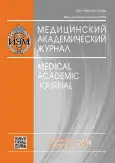CHEMICAL SYNTHESIS AND ANALYSIS OF ANTIMICROBIAL AND HEMOLYTIC ACTIVITY OF STRUCTURAL ANALOGOUS OF A PEPTIDE PROTEGRIN 1
- Authors: Kopeykin PM1, Sukhareva MS1,2, Lugovkina NV1, Shamova OV1
-
Affiliations:
- Institute of Experimental Medicine, Saint Petersburg
- Peter the Great SPbPU, Saint Petersburg
- Issue: Vol 19, No 1S (2019)
- Pages: 169-170
- Section: Articles
- Published: 15.12.2019
- URL: https://journals.eco-vector.com/MAJ/article/view/19382
- ID: 19382
Cite item
Abstract
Search for new tools for combating infectious diseases and investigation of molecular mechanisms of their antimicrobial action in in vitro and in vivo models are the urgent tasks of experimental medicine and pathophysiology. A promising direction for the development of new effective antibiotic drugs is creation of analogues of natural protective molecules that provide a host defense against pathogenic bacteria, in particular analogues of antimicrobial peptides of the innate immune system. The aim of our work was design, chemical synthesis and characterization of antimicrobial and hemolytic activity of a peptide protegrin 1 (PG1) structural variants. Three analogues of PG1 were produced and studied, it was shown that two PG1 variants exhibit a high activity against antibiotic-resistant bacteria. A comparative analysis of the hemolytic activity of the peptides towards human erythrocytes was carried out. The ways of further work directed to creation of novel antimicrobials based on a natural peptide PG1 for combating drug-resistant bacteria are outlined.
Full Text
About the authors
P M Kopeykin
Institute of Experimental Medicine, Saint Petersburg
M S Sukhareva
Institute of Experimental Medicine, Saint Petersburg; Peter the Great SPbPU, Saint Petersburg
N V Lugovkina
Institute of Experimental Medicine, Saint Petersburg
O V Shamova
Institute of Experimental Medicine, Saint Petersburg
References
- Kokryakov VN, Harwig SS, Panyutich EA, et al. Protegrins: Leukocyte antimicrobial peptides that combine features of corticostatic defensins and tachyplesins. FEBS Lett. 1993;327:231-236.
- Haney EF, Mansour SC, Hancock REW. Antimicrobial Peptides: An Introduction. In: Antimicrobial Peptides. Methods in Molecular Biology, vol. 1548. Ed. by P. Hansen. New York, NY: Humana Press; 2017. P. 3-22.
- Antibacterial Peptide Protocols. Ed. by W. Shafer. Totowa, NJ: Humana Press Inc.; 1997. 267 p.
Supplementary files







